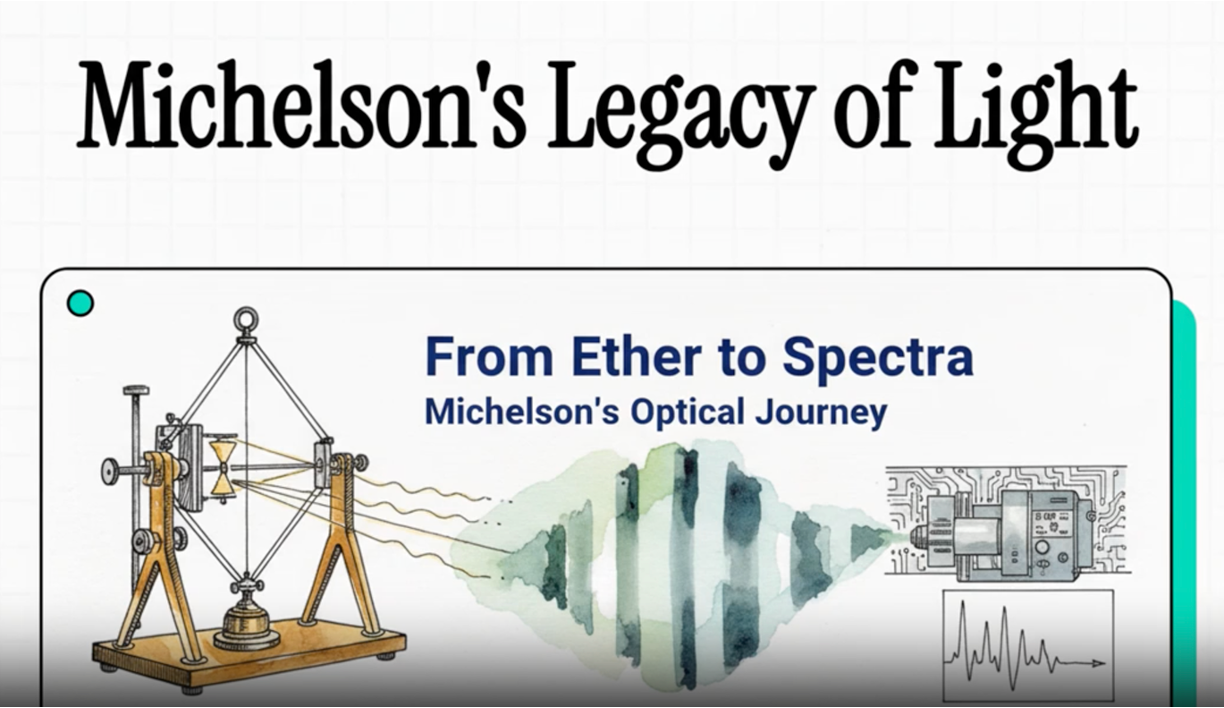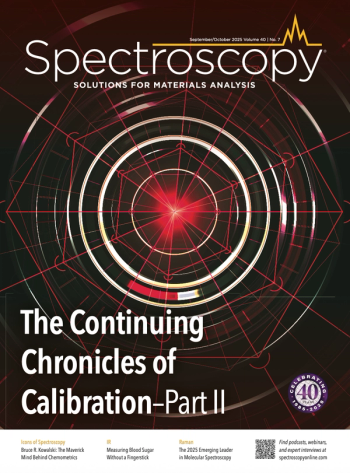
Albert A. Michelson: Precisely Measuring the Speed of Light
This video in the Icons of Spectroscopy series highlights the life and scientific achievements of Albert A. Michelson, the first American Nobel Laureate in the sciences. It traces his journey from his early years in the American West and his education at the U.S. Naval Academy to his groundbreaking experiments measuring the speed of light. We explore his invention of the Michelson interferometer, its role in the famous Michelson–Morley experiment, and its lasting influence on modern optical and spectroscopic methods, including astronomy.
Albert Abraham Michelson’s life is a story of precision, perseverance, and the transformative power of curiosity. Born in 1852 in Strelno, Prussia (now Strzelno, Poland), and raised in the rugged landscape of the American West, Michelson became the first American Nobel Laureate in the sciences. His pioneering work in optics and the measurement of the speed of light redefined experimental physics and laid the foundation for the modern field of Fourier transform infrared spectroscopy (FT-IR).
This video presentation, part of the Icons of Spectroscopy series, explores Michelson’s remarkable journey—from his early fascination with light to the creation of instruments that changed how science measures the physical world.
The Making of a Scientist
Michelson’s early years were marked by curiosity and a keen sense of observation. His family emigrated to the United States in 1854, settling in Nevada and later in California. Growing up amid the energy of the American frontier, young Albert developed an instinct for experimentation and precision. These qualities would define his scientific career.
At age 17, Michelson received an appointment to the U.S. Naval Academy from President Ulysses S. Grant—a pivotal moment that set his path in motion. Though the Academy emphasized naval tactics, Michelson’s natural affinity for mathematics and physics quickly became apparent. After graduating in 1873, he returned to teach physics and chemistry at Annapolis, where he began a lifelong obsession: accurately measuring the speed of light.
Measuring the Speed of Light
In the late 1870s, Michelson refined Léon Foucault’s experimental approach, using a rotating mirror to measure the time it took light to travel between two points. By lengthening the optical path and improving the precision of his apparatus, Michelson achieved results that surpassed all prior measurements. His 1879 determination of 186,325 miles per second was an extraordinary leap in accuracy and a milestone in physical science.
This achievement, conducted on the grounds of the U.S. Naval Academy, symbolized Michelson’s dual commitment to scientific rigor and education. It demonstrated that meticulous engineering and careful measurement could yield discoveries of global significance. The American Physical Society has since designated the Naval Academy as a Historic Site in recognition of Michelson’s pioneering work.
The Michelson Interferometer
Michelson’s most enduring invention—the interferometer—was first conceived in 1881. This elegant optical instrument splits a beam of light into two paths, reflects them, and recombines them to produce interference fringes. Subtle shifts in these fringes reveal differences in optical path length, enabling extraordinarily precise measurements.
Michelson, in collaboration with Edward W. Morley, used this device in 1887 to conduct one of the most famous experiments in physics: the Michelson–Morley experiment. Designed to detect the Earth’s motion through the hypothetical “luminiferous ether,” it produced a null result—no detectable change in light speed regardless of direction. This unexpected outcome helped pave the way for Einstein’s theory of special relativity and reshaped the scientific understanding of light and space.
Laying the Groundwork for Modern Spectroscopy
While Michelson never built an FT-IR instrument himself, his interferometer became its conceptual and mechanical heart. In Fourier transform spectroscopy, a broadband beam of light is split, recombined, and recorded as an interferogram, which is then mathematically transformed to produce a high-resolution spectrum. This principle—directly descended from Michelson’s 19th-century experiments—revolutionized spectroscopy in the 20th century.
Modern FT-IR spectrometers rely on the very same optical configuration Michelson devised: a beam splitter, two mirrors (one fixed, one moving), and the precise analysis of interference fringes. His pioneering designs made it possible to achieve superior signal-to-noise ratios, rapid spectral acquisition, and high spectral resolution—features that define contemporary spectroscopic practice.
Michelson’s influence extends even further. His meticulous optical engineering, his measurement of cadmium spectral lines to define a standard of length, and his innovations in multiple-beam interferometry all directly contributed to the precision and reliability of modern spectroscopic techniques.
Teacher, Engineer, Visionary
After resigning from the Navy, Michelson taught and conducted research at several institutions, including the Case School of Applied Science, Clark University, and the University of Chicago, where he became the first head of the physics department. His teaching style was demanding and exacting, yet deeply inspiring to students and colleagues.
During World War I, Michelson returned to naval service, designing range-finding instruments that were later integrated into U.S. military equipment. In his later years, he applied interferometric methods to astronomy, measuring the diameters of distant stars—an achievement that bridged the worlds of optics and astrophysics.
Recognition and Lasting Impact
Michelson’s precision instruments and optical innovations earned him a long list of international honors, including the Rumford Prize, the Copley Medal, and in 1907, the Nobel Prize in Physics—the first awarded to an American scientist. His work transformed measurement science and elevated American physics onto the world stage.
More importantly, his legacy endures in every laboratory where light is used to probe matter. Every FT-IR spectrometer, Raman instrument, and optical interferometer owes a debt to Michelson’s ingenuity. His insistence on accuracy and his creative mastery of optical tools set the standard for experimental science that persists today.
Conclusion
Albert A. Michelson transformed the abstract pursuit of measuring light into a practical, precise, and profoundly influential science. His inventions not only advanced physics but also created the experimental foundation for modern optical spectroscopy. The video accompanying this article celebrates Michelson’s life and legacy—his craftsmanship, his teaching, and his unyielding pursuit of perfection.
From the shimmering interference fringes of his first experiments to the advanced interferometers used in today’s laboratories, Michelson’s spirit of precision endures. His instruments turned light into one of science’s most revealing tools—illuminating, quite literally, the structure of the universe.
Reference
Workman, J., Jr. Albert A. Michelson: A Pioneer of Interferometry and Precision Optical Spectroscopy. Spectroscopy 2025, 40(6), 22–26. DOI:
Newsletter
Get essential updates on the latest spectroscopy technologies, regulatory standards, and best practices—subscribe today to Spectroscopy.






